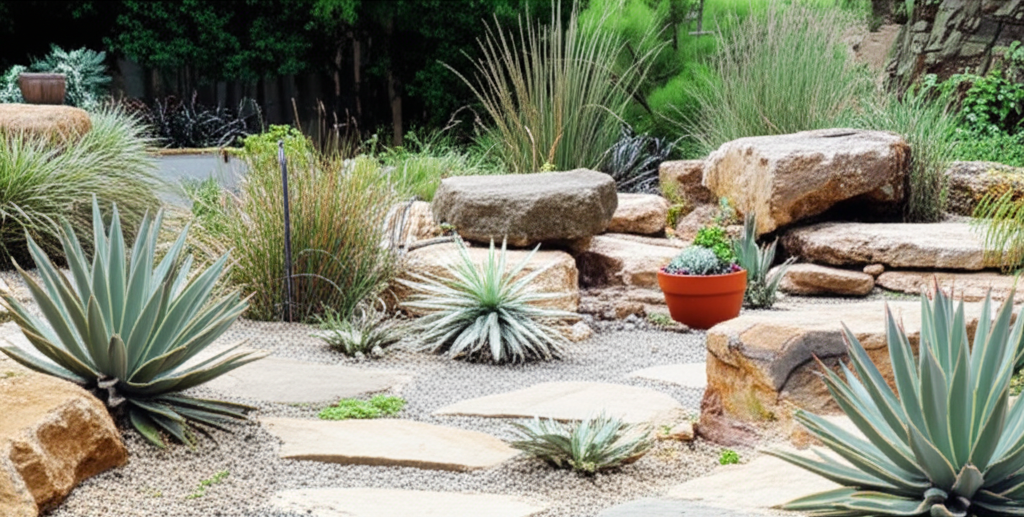
Plant lover! Let’s be honest, gardening can be a lot of work. Between the weeding, watering, and constant pruning, it’s easy to feel overwhelmed. But what if I told you you could enjoy the beauty of a thriving garden without spending your entire weekend tending to it? That’s the magic of low-maintenance garden ideas. This isn’t about neglecting your plants; it’s about smart choices that minimize the effort while maximizing the gorgeous results. Let’s dive in!
Benefits of Choosing Low-Maintenance Garden Ideas
Why choose a low-maintenance approach? Well, there are plenty of good reasons! Think of it as life-hacking your green space.
More Free Time:
The biggest perk? More time for you! Less time spent weeding and watering means more time for hobbies, family, friends, or simply relaxing. Low-maintenance gardening allows you to enjoy the fruits (and flowers!) of your labor without sacrificing your valuable free time.
Reduced Stress:
Let’s face it, gardening can be stressful. Pest infestations, wilting plants, and endless chores can take a toll. With low-maintenance garden ideas, you reduce the pressure and enjoy a more relaxing experience. The beauty of a simpler garden is its simplicity.
Lower Costs:
Low-maintenance gardens often translate to lower costs. You’ll need less water, fewer fertilizers, and potentially fewer tools. Smart plant choices and design can significantly cut down on expenses in the long run.
Environmentally Friendly:
Low-maintenance often goes hand-in-hand with sustainable practices. Using drought-tolerant plants reduces water consumption, and minimizing the use of chemical fertilizers and pesticides protects the environment. It’s a win-win for your garden and the planet!
How to Get Started with Low-Maintenance Garden Ideas
Ready to create your own effortless oasis? Here’s how to get started:
1. Choose the Right Plants:
This is the cornerstone of any low-maintenance garden. Opt for native plants that are naturally adapted to your climate. They’re less demanding and more resilient to local pests and diseases. Consider drought-tolerant plants, which require minimal watering once established. Succulents, lavender, sedum, and many grasses are excellent examples.
2. Smart Garden Design:
Think strategically about your garden’s layout. Group plants with similar water and sun requirements together. This simplifies watering and reduces wasted effort. Consider using raised beds or containers – these improve drainage and make weeding easier.
3. Mulching Magic:
Mulch is your best friend in low-maintenance gardening. It suppresses weeds, retains moisture, and regulates soil temperature, reducing the need for frequent watering and weeding. Use organic mulches like wood chips or straw for added benefits.
4. Xeriscaping:
Xeriscaping, a landscaping approach that conserves water, is perfect for low-maintenance gardens. It involves choosing drought-tolerant plants, efficient irrigation systems, and water-wise design principles. It’s a fantastic way to create a beautiful garden while reducing your water footprint.
5. Embrace the “Wildflower” Look:
Don’t be afraid to let your garden have a bit of a wild side! Allowing some self-seeding wildflowers and grasses can add to the beauty and biodiversity of your space, while requiring minimal maintenance.
6. Consider Groundcovers:
Groundcovers are fantastic for suppressing weeds and creating a lush, low-maintenance landscape. They spread quickly, filling in spaces and minimizing bare soil. Creeping thyme, clover, and certain types of ivy are great options.
Tips and Important Things to Know About Low-Maintenance Garden Ideas
Even low-maintenance gardens need a little TLC. Here are some crucial tips:
Regular (but not excessive) Watering:
Deep, infrequent watering is more beneficial than shallow, frequent watering. This encourages deep root growth, making plants more drought-tolerant.
Occasional Weeding:
While the goal is to minimize weeding, you’ll still need to pull out occasional weeds, especially in the beginning. Mulching significantly reduces weed growth.
Proper Pruning:
Regular pruning (though not always necessary) can help maintain the shape and size of your plants, preventing them from becoming overgrown and unmanageable. Research the specific pruning needs of your chosen plants.
Pest and Disease Monitoring:
Even low-maintenance plants can suffer from pests or diseases. Regular monitoring and prompt action (using natural pest control methods whenever possible) are key.
Soil Improvement:
Healthy soil is essential for healthy plants. Amend your soil with compost or other organic matter to improve its structure, drainage, and nutrient content. This makes your plants more resilient and less prone to problems.
Frequently Asked Questions (FAQs) about Low-Maintenance Garden Ideas
Let’s tackle some common questions about creating a low-maintenance garden.
Q: Can I still have colorful flowers in a low-maintenance garden?
A: Absolutely! Many low-maintenance plants boast vibrant blooms. Think perennials like coneflowers, daylilies, and lavender, or annuals that reseed themselves easily.
Q: What if I have a shady garden?
A: Don’t worry! Plenty of shade-loving plants are low-maintenance. Hostas, ferns, and astilbes are excellent choices.
Q: Is low-maintenance gardening boring?
A: Definitely not! With thoughtful planning and plant selection, you can create a stunning and varied garden that requires minimal upkeep.
Q: How much time should I expect to spend maintaining my low-maintenance garden?
A: This depends on the size and complexity of your garden. But generally, you should be able to spend significantly less time than with a high-maintenance garden—perhaps an hour or two a week once it’s established.
Q: Can I still grow vegetables in a low-maintenance garden?
A: Yes, you can! Choose low-maintenance vegetable varieties like bush beans, zucchini, and tomatoes that are relatively pest-resistant and require less attention.
Conclusion: Embrace the Effortless Beauty of Low-Maintenance Garden Ideas
Creating a beautiful and thriving garden doesn’t have to be a constant battle. With smart planning and the right plant choices, you can enjoy all the benefits of gardening without the endless work. So, ditch the digging and embrace the effortless beauty of low-maintenance garden ideas. Start small, experiment with different plants, and soon you’ll have a stunning garden that you can truly enjoy—without sacrificing your precious time and energy! Ready to get started? Let us know in the comments what your favorite low-maintenance plants are!